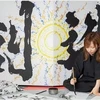 People worship in front of the altar at Keo Pagoda. Located in Vu Thu district, the northern province of Thai Binh, the pagoda was first built in 1061 as Nghiem Quang pagoda. It was destroyed by a typhoon in 1611 and rebuilt in 1632 in the Le dynasty, and is one of the oldest Buddhist architecture works in Vietnam. Despite several upgrades and repairs over the past 400 years, Keo Pagoda still retains its unique architecture from the 17th century. It is surrounded by three lakes, one in the front and two at both sides, creating a beautiful surrounding. The front section is dedicated to worshipping Buddha. At its rear is the area for worshipping the founder of the pagoda. (Photo: VietnamPlus)
People worship in front of the altar at Keo Pagoda. Located in Vu Thu district, the northern province of Thai Binh, the pagoda was first built in 1061 as Nghiem Quang pagoda. It was destroyed by a typhoon in 1611 and rebuilt in 1632 in the Le dynasty, and is one of the oldest Buddhist architecture works in Vietnam. Despite several upgrades and repairs over the past 400 years, Keo Pagoda still retains its unique architecture from the 17th century. It is surrounded by three lakes, one in the front and two at both sides, creating a beautiful surrounding. The front section is dedicated to worshipping Buddha. At its rear is the area for worshipping the founder of the pagoda. (Photo: VietnamPlus)  The altar is the place to put objects for worship, such as incense burners, flower vases, oil lamps, and offerings. When worshipping, people will light incense sticks, put them in the incense burners, and pray. The altar in Keo Pagoda has a length of 227 centimetres, a width of 156 centimetres and a height of 153 centimetres. It has been recognized as a national treasure considering its great cultural, artistic and historical value. A ceremony was held in the Vu Thu district of Thai Binh province on October 5, 2022 to announce the Prime Minister’s decision recognising the altar in Keo Pagoda as a national treasure. (Photo: VietnamPlus)
The altar is the place to put objects for worship, such as incense burners, flower vases, oil lamps, and offerings. When worshipping, people will light incense sticks, put them in the incense burners, and pray. The altar in Keo Pagoda has a length of 227 centimetres, a width of 156 centimetres and a height of 153 centimetres. It has been recognized as a national treasure considering its great cultural, artistic and historical value. A ceremony was held in the Vu Thu district of Thai Binh province on October 5, 2022 to announce the Prime Minister’s decision recognising the altar in Keo Pagoda as a national treasure. (Photo: VietnamPlus)  The Prime Minister’s decision recognising the altar in Keo Pagoda as a national treasure is placed near the altar. The altar in Keo Pagoda has a length of 227 centimetres, a width of 156 centimetres and a height of 153 centimetres. The Keo Pagoda, also known as Than Quang Pagoda, worships Buddha and Duong Khong Lo, a monk of the Ly dynasty, who founded the pagoda in 1632 in the Le dynasty. It is a typical example of the architectural style of ‘Buddha in front, saints in the back’ of pagodas in the northern region. Despite several upgrades and repairs over the past 400 years, Keo Pagoda retains its unique architecture from the 17th century. (Photo: VietnamPlus)
The Prime Minister’s decision recognising the altar in Keo Pagoda as a national treasure is placed near the altar. The altar in Keo Pagoda has a length of 227 centimetres, a width of 156 centimetres and a height of 153 centimetres. The Keo Pagoda, also known as Than Quang Pagoda, worships Buddha and Duong Khong Lo, a monk of the Ly dynasty, who founded the pagoda in 1632 in the Le dynasty. It is a typical example of the architectural style of ‘Buddha in front, saints in the back’ of pagodas in the northern region. Despite several upgrades and repairs over the past 400 years, Keo Pagoda retains its unique architecture from the 17th century. (Photo: VietnamPlus)  The altar recognized as a national treasure is placed in the worshipping area dedicated to monk Duong Khong Lo, a monk of the Ly dynasty, who founded the pagoda. Duong Khong Lo was born in 1016 in Giao Thuy district, the northern province of Nam Dinh. He became a monk at 29. In 1061, after practicing Buddhism in India, he returned home and founded Nghiem Quang pagoda. In 1167, King Ly Anh Tong changed the name of the pagoda from Nghiem Quang to Than Quang. However, it was destroyed by a typhoon in 1611 and rebuilt in 1632. The monk is said to have cured King Le Thanh Tong of illness. (Photo: VietnamPlus)
The altar recognized as a national treasure is placed in the worshipping area dedicated to monk Duong Khong Lo, a monk of the Ly dynasty, who founded the pagoda. Duong Khong Lo was born in 1016 in Giao Thuy district, the northern province of Nam Dinh. He became a monk at 29. In 1061, after practicing Buddhism in India, he returned home and founded Nghiem Quang pagoda. In 1167, King Ly Anh Tong changed the name of the pagoda from Nghiem Quang to Than Quang. However, it was destroyed by a typhoon in 1611 and rebuilt in 1632. The monk is said to have cured King Le Thanh Tong of illness. (Photo: VietnamPlus)  The altar recognized as a national treasure is made of wood. It has a length of 227 centimetres, a width of 156 centimetres and a height of 153 centimetres. According to many researchers, the altar is the largest among crimson and gilded altars at worshipping and religious relic sites in Vietnam. It is placed in the worshipping area dedicated to monk Duong Khong Lo, a monk of the Ly dynasty, who founded the pagoda. Keo Pagoda is a typical example of the architectural style of ‘Buddha in front, saints in the back’ of pagodas in the northern region. The Keo Pagoda was recognised as a special national relic in September 2012. (Photo: VietnamPlus)
The altar recognized as a national treasure is made of wood. It has a length of 227 centimetres, a width of 156 centimetres and a height of 153 centimetres. According to many researchers, the altar is the largest among crimson and gilded altars at worshipping and religious relic sites in Vietnam. It is placed in the worshipping area dedicated to monk Duong Khong Lo, a monk of the Ly dynasty, who founded the pagoda. Keo Pagoda is a typical example of the architectural style of ‘Buddha in front, saints in the back’ of pagodas in the northern region. The Keo Pagoda was recognised as a special national relic in September 2012. (Photo: VietnamPlus)  There are three special points about the altar that is recognized as a national treasure at Keo Pagoda, which are its big size, the dense layers of carvings and a system of wheels at its legs. This shows that at the time, the position and function of the altar were not limited to a fixed space. The altar, which is decorated with elaborate and delicate carvings, has been preserved almost intact. This is a handmade product with more than 1,000 skillfully carved motifs in a tight layout. Besides the altar, the pagoda is home to numerous valuable artifacts from the 17th century under Hau Le dynasty, including reading tables, altars, statues, bells, steles, horizontal lacquered boards and parallel texts and books. (Photo: VietnamPlus)
There are three special points about the altar that is recognized as a national treasure at Keo Pagoda, which are its big size, the dense layers of carvings and a system of wheels at its legs. This shows that at the time, the position and function of the altar were not limited to a fixed space. The altar, which is decorated with elaborate and delicate carvings, has been preserved almost intact. This is a handmade product with more than 1,000 skillfully carved motifs in a tight layout. Besides the altar, the pagoda is home to numerous valuable artifacts from the 17th century under Hau Le dynasty, including reading tables, altars, statues, bells, steles, horizontal lacquered boards and parallel texts and books. (Photo: VietnamPlus)  The altar - national treasure at Keo Pagoda is the largest among the crimson and gilded altars found so far at worshipping and religious relic sites in Vietnam. It has a length of 227 centimetres, a width of 156 centimetres and a height of 153 centimetres. There are three special points about the national treasure at Keo Pagoda, which are its big size, the dense layers of carvings and a system of wheels at its legs. This shows that at the time, the position and function of the altar were not limited to a fixed space. The altar is decorated with elaborate and delicate carvings and has been preserved almost intact. (Photo: VietnamPlus)
The altar - national treasure at Keo Pagoda is the largest among the crimson and gilded altars found so far at worshipping and religious relic sites in Vietnam. It has a length of 227 centimetres, a width of 156 centimetres and a height of 153 centimetres. There are three special points about the national treasure at Keo Pagoda, which are its big size, the dense layers of carvings and a system of wheels at its legs. This shows that at the time, the position and function of the altar were not limited to a fixed space. The altar is decorated with elaborate and delicate carvings and has been preserved almost intact. (Photo: VietnamPlus)  The altar is a handmade product with more than 1,000 skillfully carved motifs in a tight layout, including 550 lotus petals and 435 chrysanthemum flowers. The altar, which is decorated with elaborate and delicate carvings, has been preserved almost intact. According to many researchers, the altar has a great historical, cultural, artistic, and technical value, and is the largest among the crimson and gilded altars at the worshipping and religious relic sites in Vietnam. Besides the altar, the pagoda is home to numerous valuable artifacts from the 17th century under the Hau Le dynasty, including reading tables, altars, statues, bells, steles, horizontal lacquered boards and parallel texts and books. (Photo: VietnamPlus)
The altar is a handmade product with more than 1,000 skillfully carved motifs in a tight layout, including 550 lotus petals and 435 chrysanthemum flowers. The altar, which is decorated with elaborate and delicate carvings, has been preserved almost intact. According to many researchers, the altar has a great historical, cultural, artistic, and technical value, and is the largest among the crimson and gilded altars at the worshipping and religious relic sites in Vietnam. Besides the altar, the pagoda is home to numerous valuable artifacts from the 17th century under the Hau Le dynasty, including reading tables, altars, statues, bells, steles, horizontal lacquered boards and parallel texts and books. (Photo: VietnamPlus)  The carvings on the altar are intricate and elaborate, with careful layout, creating many layers with exquisite details. The altar has been preserved almost intact. It has been recognized as a national treasure considering its great cultural, artistic and historical value. Keo Pagoda is not only a place of worship but also one to learn more about Buddhism and to explore the history and culture of Vietnam. Keo pagoda is located in Duy Nhat commune, Vu Thu district, Thai Binh province, about 100km from Hanoi. First built in 1061 as Nghiem Quang pagoda, the pagoda was destroyed by a typhoon in 1611 and rebuilt in 1632. It is one of the oldest pagodas in Vietnam which still retains almost all the original architecture. (Photo: VietnamPlus)
The carvings on the altar are intricate and elaborate, with careful layout, creating many layers with exquisite details. The altar has been preserved almost intact. It has been recognized as a national treasure considering its great cultural, artistic and historical value. Keo Pagoda is not only a place of worship but also one to learn more about Buddhism and to explore the history and culture of Vietnam. Keo pagoda is located in Duy Nhat commune, Vu Thu district, Thai Binh province, about 100km from Hanoi. First built in 1061 as Nghiem Quang pagoda, the pagoda was destroyed by a typhoon in 1611 and rebuilt in 1632. It is one of the oldest pagodas in Vietnam which still retains almost all the original architecture. (Photo: VietnamPlus)  A close-up of the body of the altar. The altar was decorated with elaborate and delicate carvings with more than 1,000 skillfully carved motifs in a tight layout, including 550 lotus petals and 435 chrysanthemum flowers. The altar has been preserved almost intact. According to many researchers, the altar has a great historical, cultural, artistic, and technical value, and is the largest among the crimson and gilded altars at the worshipping and religious relic sites in Vietnam. There are three special points about the altar that is recognized as a national treasure at Keo Pagoda. These are its big size, the dense layers of carvings and a system of wheels at its legs, making it easy to move the altar around. (Photo: VietnamPlus)
A close-up of the body of the altar. The altar was decorated with elaborate and delicate carvings with more than 1,000 skillfully carved motifs in a tight layout, including 550 lotus petals and 435 chrysanthemum flowers. The altar has been preserved almost intact. According to many researchers, the altar has a great historical, cultural, artistic, and technical value, and is the largest among the crimson and gilded altars at the worshipping and religious relic sites in Vietnam. There are three special points about the altar that is recognized as a national treasure at Keo Pagoda. These are its big size, the dense layers of carvings and a system of wheels at its legs, making it easy to move the altar around. (Photo: VietnamPlus)  First altars in Buddhist pagodas in Vietnam date back as early as in the Ly – Tran dynasties (1009 – 1400 A.D.) and Early Le – Mac dynasty (1428-1592) but most were made of stone and earthenware. Crimson and gilded altars made of wood were believed to appear in the Le Trung Hung (Revival Le) dynasty (1533–1789). Rebuilt in 1632, Keo Pagoda is one of the oldest pagodas in Vietnam which still retains almost all the original architecture. The pagoda now has 128 apartments covering 2,000 sq.m. Despite several upgrades and repairs over the past 400 years, Keo Pagoda keeps its unique architecture from the 17th century. (Photo: VietnamPlus)
First altars in Buddhist pagodas in Vietnam date back as early as in the Ly – Tran dynasties (1009 – 1400 A.D.) and Early Le – Mac dynasty (1428-1592) but most were made of stone and earthenware. Crimson and gilded altars made of wood were believed to appear in the Le Trung Hung (Revival Le) dynasty (1533–1789). Rebuilt in 1632, Keo Pagoda is one of the oldest pagodas in Vietnam which still retains almost all the original architecture. The pagoda now has 128 apartments covering 2,000 sq.m. Despite several upgrades and repairs over the past 400 years, Keo Pagoda keeps its unique architecture from the 17th century. (Photo: VietnamPlus)  Compared to altars in the previous period, crimson and gilded altars made of wood are decorated with more carvings in brighter colours. The carvings on the altar are intricate and elaborate, with careful layout, creating many layers with exquisite details. There are three special points about the altar at Keo Pagoda, which are its big size, the dense layers of carvings and a system of wheels at its legs, making it easy to move the altar around. According to many researchers, the altar has a great historical, cultural, artistic, and technical value. Keo Pagoda has been well preserved even though its structures are made mostly from wood. (Photo: VietnamPlus)
Compared to altars in the previous period, crimson and gilded altars made of wood are decorated with more carvings in brighter colours. The carvings on the altar are intricate and elaborate, with careful layout, creating many layers with exquisite details. There are three special points about the altar at Keo Pagoda, which are its big size, the dense layers of carvings and a system of wheels at its legs, making it easy to move the altar around. According to many researchers, the altar has a great historical, cultural, artistic, and technical value. Keo Pagoda has been well preserved even though its structures are made mostly from wood. (Photo: VietnamPlus)  A close view of the altar legs, which are covered with ornate patterns of cloud, fire and water. The elaborate and intricate carvings on the altar are what make it stand out. Keo Pagoda is not only a place of worshiping but also one to learn more about Buddhism and to explore the history and culture of ancient Vietnam. The pagoda boasts almost 100 statues, making it a museum of Buddha statues. In the pagoda, there is also a special area dedicated to Duong Khong Lo, a monk of the Ly dynasty, who founded the pagoda. Keo Pagoda is a typical example of the architectural style of ‘Buddha in front, saints in the back’ of pagodas in the northern region. (Photo: VietnamPlus)
A close view of the altar legs, which are covered with ornate patterns of cloud, fire and water. The elaborate and intricate carvings on the altar are what make it stand out. Keo Pagoda is not only a place of worshiping but also one to learn more about Buddhism and to explore the history and culture of ancient Vietnam. The pagoda boasts almost 100 statues, making it a museum of Buddha statues. In the pagoda, there is also a special area dedicated to Duong Khong Lo, a monk of the Ly dynasty, who founded the pagoda. Keo Pagoda is a typical example of the architectural style of ‘Buddha in front, saints in the back’ of pagodas in the northern region. (Photo: VietnamPlus)  The back of the altar is also decorated with intricate carvings. Vietnamese used altars as early as in the Ly – Tran dynasties (1009 – 1400 A.D.) and Early Le – Mac dynasty (1428-1592) but most were made of stone and earthenware. Crimson and gilded altars made of wood were believed to appear in the Le Trung Hung (Revival Le) dynasty (1533–1789). Compared to altars in the previous period, crimson and gilded altars made of wood are decorated with more carvings in brighter colours. The Keo pagoda is home to a wealth of ancient artefacts. They range from intricately engraved wooden dragons to a collection of over 100 statues. (Photo: VietnamPlus)
The back of the altar is also decorated with intricate carvings. Vietnamese used altars as early as in the Ly – Tran dynasties (1009 – 1400 A.D.) and Early Le – Mac dynasty (1428-1592) but most were made of stone and earthenware. Crimson and gilded altars made of wood were believed to appear in the Le Trung Hung (Revival Le) dynasty (1533–1789). Compared to altars in the previous period, crimson and gilded altars made of wood are decorated with more carvings in brighter colours. The Keo pagoda is home to a wealth of ancient artefacts. They range from intricately engraved wooden dragons to a collection of over 100 statues. (Photo: VietnamPlus)  The altar at Keo Pagoda is a masterpiece of the wood carving art not only in the Revival Le dynasty but also throughout the history of the art in Vietnam. There are three special points about the national treasure at Keo Pagoda, which are its big size, the dense layers of carvings and a system of wheels at its legs, making it easy to move the altar around. The pagoda has also preserved many valuable antiques, such as a pair of candlesticks from the Mac Dynasty, pottery and altars from the Le Dynasty and several imperial boats. The Keo Pagoda was recognised as a special national relic in September 2012. (Photo: VietnamPlus)
The altar at Keo Pagoda is a masterpiece of the wood carving art not only in the Revival Le dynasty but also throughout the history of the art in Vietnam. There are three special points about the national treasure at Keo Pagoda, which are its big size, the dense layers of carvings and a system of wheels at its legs, making it easy to move the altar around. The pagoda has also preserved many valuable antiques, such as a pair of candlesticks from the Mac Dynasty, pottery and altars from the Le Dynasty and several imperial boats. The Keo Pagoda was recognised as a special national relic in September 2012. (Photo: VietnamPlus)  The altar at Keo Pagoda is a treasure with its great historical, cultural and artistic values. It is a one-of-a-kind original artifact. Do Ngoc Trung, head of the Culture and Information Office of Vu Thu district, said the district authorities have been promoting educational activities to raise the awareness of both officials and people on the need to preserve the local relic. Keo pagoda itself is a special national relic site. It is one of the ancient pagodas in Vietnam with over 400-year-old well preserved architecture. Besides being a fine example of Vietnamese architecture and the annual venue for a magnificent festival, Keo Pagoda has an interesting history, closely linked to the pagoda’s founder. (Photo: VietnamPlus)
The altar at Keo Pagoda is a treasure with its great historical, cultural and artistic values. It is a one-of-a-kind original artifact. Do Ngoc Trung, head of the Culture and Information Office of Vu Thu district, said the district authorities have been promoting educational activities to raise the awareness of both officials and people on the need to preserve the local relic. Keo pagoda itself is a special national relic site. It is one of the ancient pagodas in Vietnam with over 400-year-old well preserved architecture. Besides being a fine example of Vietnamese architecture and the annual venue for a magnificent festival, Keo Pagoda has an interesting history, closely linked to the pagoda’s founder. (Photo: VietnamPlus)  Keo Pagoda attracts a large number of Buddhist followers. According to the head of the Culture and Information Department of Vu Thu district, Do Ngoc Trung, the department has sought advice from the Thai Binh Museum in methods to best preserve the altar at Keo Pagoda. The department will also propose to the provincial Culture, Sports and Tourism Department to allow the production of a model of the national treasure for display. In September 2012, the pagoda was designated as a special national relic. The festival at the pagoda was also added to the national intangible cultural heritage list in 2017. The festival is held annually from the 10th to 15th day of the ninth lunar month to honour the founder of the pagoda. (Photo: VietnamPlus)
Keo Pagoda attracts a large number of Buddhist followers. According to the head of the Culture and Information Department of Vu Thu district, Do Ngoc Trung, the department has sought advice from the Thai Binh Museum in methods to best preserve the altar at Keo Pagoda. The department will also propose to the provincial Culture, Sports and Tourism Department to allow the production of a model of the national treasure for display. In September 2012, the pagoda was designated as a special national relic. The festival at the pagoda was also added to the national intangible cultural heritage list in 2017. The festival is held annually from the 10th to 15th day of the ninth lunar month to honour the founder of the pagoda. (Photo: VietnamPlus) VNA



















